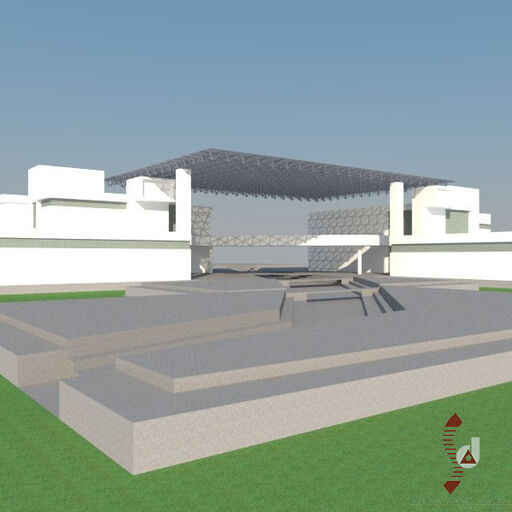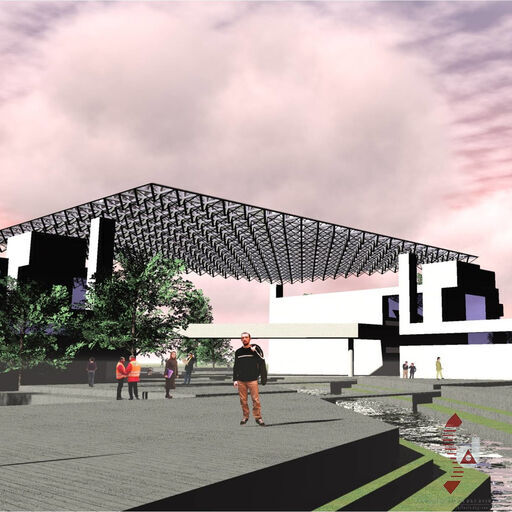RSC Mysore is Institutional architectural project designed by SDAARCHITECT, located in Mysore, Karnataka.
Project Info
| Client |
National Council of Science Museums |
|---|---|
| Project Type |
Institutional |
| State |
Karnataka |
| City | Mysore |
| Team |
Sunando Dasgupta Dinakar Venugopal |
| Status | Design Proposal |
Architectural Renders
Site Analysis
Location
The proposed site for the Regional Science Center is located in Mysore, Karnataka, within the campus of Mysore University on Hunsur Road. The site is strategically positioned, ensuring easy accessibility by public transport, which is crucial for the anticipated large number of visitors.
Topography
The site spans 7 acres and is characterized by a fairly flat terrain. A stream runs diagonally across the site, creating a natural feature that enhances the overall landscape. The site is also surrounded by a large number of trees, which contribute to the site's microclimate and aesthetic appeal.
Elevation
The site is situated at an elevation of 763 meters above sea level. This elevation provides a vantage point that influences the climatic conditions and contributes to the overall environmental setting of the site.
Climate
The climate of Mysore is classified as semi-arid according to the Köppen climate classification. The city experiences moderate temperatures, ranging from an average of 19°C to 29°C throughout the year. The average annual rainfall is approximately 804.2 mm, with the majority of rainfall occurring during the South West Monsoon.
Microclimate
The microclimate of the site is significantly influenced by the thick vegetation surrounding it, the stream that cuts across the site, and the presence of Kukrallikere (a lake) within the Mysore University campus. These elements create a localized environment that is cooler and more humid compared to the surrounding areas, contributing to the overall comfort and ambiance of the site.
Seismic Zone
The site is located in Seismic Zone 2, which is considered a low-risk zone for earthquakes. This classification is important for the structural planning and design of the buildings within the site, ensuring safety and resilience.
Design Concept
Design Intent
The Regional Science Center is envisioned as an activity-based learning environment that fosters scientific curiosity and education among the public. The center is designed to achieve this through a dual approach: interactive exhibits and participatory demonstrations. These features are aimed at making the learning process engaging and enjoyable for both children and adults, encouraging a deeper understanding of scientific principles.
Abstract
The design of the Regional Science Center draws inspiration from the architectural and urban heritage of Mysore. The city is known for its harmonious blend of architectural buildings, open spaces, lakes, and the scenic backdrop of Chamundi Hills. Mysore’s urban fabric is characterized by long boulevards, well-defined central axes, and public buildings that are thoughtfully recessed and balanced. The design acknowledges the city's rich heritage, which includes tangible elements like monuments and heritage buildings, as well as intangible cultural values.
Concept Derivation
The design concept is deeply rooted in both the city of Mysore and the specific characteristics of the site. The natural features of the site, particularly the stream running diagonally through it, form the central axis or spine of the design. This axis serves as the organizing principle around which the outdoor Science Park is developed, with the park sandwiched between two building blocks. The design carefully preserves these natural elements, integrating them into the overall experience of the science center.
The architectural expression of the center reflects Mysore’s diverse architectural styles, including Indo-Saracenic, Traditional Hindu, Greco-Roman, Gothic, European Classical, and Traditional Bungalows. The design seeks to create a building image that resonates with Mysore’s architectural legacy while addressing contemporary needs.
Architectural Image
An important aspect of the design is the effort to capture an appropriate architectural image that is both reflective of Mysore’s rich heritage and responsive to the modern context. The design balances the historical and cultural significance of the city with the functional requirements of a modern science center, creating a space that is both meaningful and effective in its purpose.
Site Layout
Main Entrance and Zoning
The site layout of the Regional Science Center in Mysore is strategically designed to maximize functionality while preserving the natural features of the area. The main entrance to the complex is located on the northern side of the site. The layout is divided into four primary zones: (a) Main exhibition area, (b) Visitors' activity area, (c) Exhibit Development Laboratory and office, and (d) Outdoor Science Park. This zoning ensures that each function is clearly defined and easily accessible.
Integration with Natural Features
The design of the site layout carefully integrates the existing natural features, such as the stream and dense vegetation, into the overall plan. The stream, which runs diagonally across the site, is used as a central axis around which the Science Park is developed. This central spine forms a key element of the design, connecting different parts of the site through footbridges and walkways. The natural landscape is preserved and enhanced, creating an immersive experience for visitors as they move through the park.
Parking and Visual Aesthetics
To maintain the visual integrity of the Science Park, parking is discreetly located in one corner of the site, away from the main areas of visitor activity. This placement ensures that the parking facilities do not interfere with the visual appeal of the park or the surrounding environment. The road network on the site is designed as a loop, connecting the two main entrance lobbies in a functional and integrated manner.
Service Access and Site Planning
The site layout includes a separate service access route that connects the auditorium to the service entry of the temporary exhibition halls and the exhibit development area. This service access is designed to facilitate the smooth movement of materials and personnel without disrupting the flow of visitors. The inward-looking site planning allows visitors to move within the proposed building and the Science Park with minimal exposure to the surrounding buildings, which are of lesser aesthetic impact.
Science Park and Building Integration
The Science Park is designed to reveal itself to visitors gradually, with landscaped zones leading to the main building. This progression is a nod to the traditional building typology of Mysore, where spaces unfold in stages. The building blocks are strategically anchored within the site to ensure that adjacent buildings retain their importance. The central spine, which runs diagonally across the site, creates a sense of expansiveness, making the space appear larger than it actually is.
Functional Layout
Building Form and Structure
The functional layout of the Regional Science Center is thoughtfully designed to accommodate various activities while preserving the natural flow of the site. The building is divided into two main parts, with the central atrium serving as a connecting space. On one side of the stream lies the main exhibition halls, while the auditorium and activity center are positioned on the opposite side. This division not only respects the natural features of the site but also enhances the visitor experience by creating distinct zones for different activities.
Pedestrian Movement
The design channels pedestrian movement from the parking area through the Science Park and the central atrium, following the same axis as the stream. This deliberate flow ensures that visitors are fully immersed in the park’s natural and educational environment before entering the main building. The seamless integration of pathways and walkways enhances the overall visitor experience, allowing easy navigation through the site.
Building Orientation and Strategic Placement
The building is oriented along a North-South axis, which helps optimize natural light and ventilation while minimizing exposure to the surrounding environment. The strategic placement of the building blocks ensures that the adjacent structures retain their significance. By anchoring the building blocks carefully within the site, the design maintains a balance between the new development and the existing campus environment.
Science Park and Visitor Experience
The Science Park is designed to guide visitors through progressively landscaped zones, eventually leading to the main building. This approach mirrors traditional Mysore architecture, where spaces are revealed gradually, enhancing the sense of discovery. The park’s layout is both functional and educational, providing an engaging outdoor environment that complements the indoor exhibits.
Building Functions
The functional layout of the building is organized to support a wide range of activities:
Ground Floor
The main exhibition block is accessed through an entrance lobby that leads to two large exhibition halls. Additional facilities on this floor include a toilet block, staircase, and lifts for vertical circulation.
First Floor
The first floor houses another exhibition hall, which is connected by an elevated walkway to the activity center on the opposite side of the atrium. This floor also includes the children’s activity area, adult training hall, and library, providing a diverse range of educational spaces.
Subsidiary Entrance
Another entrance provides access to the auditorium, 3D hall, and computer room, with additional facilities on the first floor for specialized training and activities.
Service Areas
The temporary exhibition hall, exhibit development area, and office block are supported by a loading and unloading deck at the rear, ensuring efficient service operations without disrupting visitor activities.
Movement and Circulation
Main Circulation Spine
The movement and circulation within the Regional Science Center are carefully orchestrated around a central axis formed by the natural stream that runs diagonally through the site. This stream acts as the primary circulation spine, guiding both pedestrian and vehicular movement across the site. The design leverages this natural feature to create a cohesive flow, connecting various zones of the Science Center seamlessly.
Pedestrian Flow
Pedestrian movement is thoughtfully channelized from the parking area, leading visitors through the Science Park and into the central atrium. This journey follows the same axis as the stream, ensuring that visitors are fully engaged with the site’s natural and educational elements from the moment they arrive. The design promotes a smooth and intuitive flow, allowing visitors to explore the park and buildings with ease.
Vehicular Circulation
Vehicular circulation is managed through a loop road that connects the two main entrance lobbies. This loop design facilitates easy access to different parts of the site while maintaining a clear separation between pedestrian and vehicular paths. The road network is integrated into the site layout in a way that supports functional access without disrupting the overall aesthetic and experience of the Science Center.
Service Access
A dedicated service access route is provided, connecting the auditorium to the service entry of the temporary exhibition halls and the exhibit development area. This service route is designed to operate independently of the main visitor circulation, ensuring that logistical operations such as loading and unloading can occur without interfering with the visitor experience. This separation of service and visitor circulation enhances the efficiency and functionality of the site.
Integration with the Science Park
The Science Park is designed to reveal itself progressively to visitors, with pathways and landscaped zones leading them toward the main building. This gradual unfolding of spaces mirrors the traditional planning features of Mysore’s architecture, where visitors are guided through a series of stages. Footbridges and walkways are strategically placed to connect different areas of the park and the building, reinforcing the central circulation spine and enhancing the overall experience.







